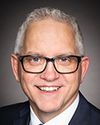Thank you, Mr. Schmale.
We'll now go to Mr. Battiste.
Monsieur Battiste, you have six minutes.
Evidence of meeting #8 for Indigenous and Northern Affairs in the 44th Parliament, 1st Session. (The original version is on Parliament’s site, as are the minutes.) The winning word was nations.
A recording is available from Parliament.
2:30 p.m.
Liberal

The Chair Liberal Marc Garneau
Thank you, Mr. Schmale.
We'll now go to Mr. Battiste.
Monsieur Battiste, you have six minutes.
March 4th, 2022 / 2:30 p.m.
Liberal

Jaime Battiste Liberal Sydney—Victoria, NS
Thank you, Mr. Chair.
I would really like to start off by congratulating and acknowledging the leadership of Regional Chief Woodhouse in getting the historic agreement-in-principle on child and family services and Jordan's principle. I know that she worked hard on that, and I want to congratulate her for her efforts on that before I get to the questions.
Also, I would like to acknowledge that I'm really happy to hear that there is an AFN chiefs committee on housing. I know that six minutes often isn't enough time to get your interventions in place, but we would be more than happy as a committee, if you have innovative approaches to housing, if you would please share that. For the next four meetings we will be doing this study, so you would have a bit of time—I would say a month—to prepare a document that can help us make better recommendations for those on reserve.
My first question is around many of the challenges on the reserve that I'm hearing about from many of my constituents, such as Chief Leroy Denny. They talk about reserves being in place for sometimes 100 years, sometimes more than 80 years, where indigenous communities were centralized in the areas by government programs and now, many years later, they're running out of land. It's hard to find land on reserve to build houses even if they have the money.
Chiefs, do you believe that a part of the solution is additions to reserve? How can we speed up the process of additions to reserve to reflect the growing population increases of first nations?
Chief Haymond, I'll start with you.
2:35 p.m.
Housing Portfolio, Assembly of First Nations Quebec-Labrador
Thank you very much for the question.
Again, I think it's really dependent upon the individual communities and the region. Most certainly, land or access to land becomes a problem. As you mentioned, when reserves were first created, many of them were only 10, 15 or 20 hectares in size, but demographic growth and legal decisions like Bill C-31 and Bill S-3 have added significant numbers of new people to our communities, and thus a requirement for additional lands.
Additions to reserve is one way of acquiring those lands. It's quite complex, difficult and challenging, and I speak from experience. It took us 10 years to double in size from 20 hectares to 40 hectares, so I speak from experience. Additions to reserve may not be the only solution. I believe Minister Miller has spoken openly about giving land back to first nations, so we're really interested in and curious as to what that could look like.
Again, as an Algonquin leader and as a community whose nation has unceded territory, we believe there may be other avenues to explore, to not solely rest on the process of additions to reserve, which, as I mentioned, takes too long, is too complex and, again, can be rather difficult when the provinces or the municipalities we're adjacent to decide they don't want to give up the land.
2:35 p.m.
Liberal

Jaime Battiste Liberal Sydney—Victoria, NS
I'm hearing you loud and clear that we need to speed up that process, and I agree with you.
Before the treaties and before settlers arrived, indigenous people were able to access their resources, such as timber and many things like that, to create their own homes and to create their own furniture.
Perhaps Cindy or Chief Haymond can answer this next question. Do you believe that housing is an aboriginal right under section 35 of the Constitution?
2:35 p.m.
Manitoba Region, Assembly of First Nations
Regional Chief Cindy Woodhouse
I absolutely feel that it's a right. It also creates economic stability in many of our first nations. More importantly, my grandfather, Chief Richard Woodhouse, signed Treaty 2 in 1871, and we were always told we had the right to housing, education and all of these other things.
It's an absolute right. More importantly, it's a human right. Every Canadian deserves a home, but we've given up a lot in this country. Many of our people are living in third world conditions, and that's unacceptable.
2:35 p.m.
Liberal

Jaime Battiste Liberal Sydney—Victoria, NS
The last question I'll ask is about housing. Housing on reserve is important for homes for people, but it's also important for creating jobs for carpenters, electricians and plumbers.
Can you talk a bit about what housing means to first nations communities on reserve?
2:35 p.m.
Manitoba Region, Assembly of First Nations
Regional Chief Cindy Woodhouse
Absolutely. I know of one community that created its own housing committee and its own housing development corporation within its first nation community. The spinoff on that was enormous to the families and to the community. It was also helpful in making sure they knew how to repair their own homes and knew how to keep the economy going. It ensured that their children, the young people who came after them, were becoming plumbers and electricians.
It was about creating economic stability for themselves and their community. It meant so much to so many people. It's so important to create an economy within first nations communities, instead of always contracting it out.
2:40 p.m.
Liberal

Jaime Battiste Liberal Sydney—Victoria, NS
I'm hearing loud and clear that housing is also part of the economy.
2:40 p.m.
Liberal

The Chair Liberal Marc Garneau
Thank you, Mr. Battiste.
Mrs. Gill, you now have the floor for six minutes.
2:40 p.m.
Bloc

Marilène Gill Bloc Manicouagan, QC
Thank you, Mr. Chair.
I would like to thank all the witnesses. I very much appreciated the testimony from Chief Woodhouse, Chief Haymond and Mr. Obed.
I was struck by two words that I find very important.
Chief Haymond, you used the word “epicentre”. Mr. Obed, you used the word “crisis”. We should keep both words in mind, not only for the entire duration of the study but also for when we are making our recommendations. As I see things, when we are talking about all the difficulties that First Nations can experience, we must absolutely retain the term “epicentre”.
I will be talking about Quebec more but clearly, it is a concern for all indigenous First Nations and Métis everywhere in Canada.
Last November, I took part in the Grand Economic Circle of Indigenous People and Quebec. I'd like to tell you a story to show the extent to which the housing issue is important for First Nations in Quebec.
I wanted to take part in a number of the activities. A number of sessions were scheduled, including one on housing. All the chiefs told me that I should absolutely take part in the one given by the Assembly of First Nations Quebec‑Labrador, the AFNQL. I know that Chief Haymond was there. For the chiefs, it was an absolute priority. The effects were a major topic and Chief Haymond talked about them a great deal.
Chief Haymond, could you tell us about the various solutions that are possible? You talked about underfunding.
Could you tell us, for example, about housing strategies for Quebec? Is there another solution you would like to propose?
2:40 p.m.
Housing Portfolio, Assembly of First Nations Quebec-Labrador
Absolutely, and thank you for the question.
While we hear and we speak about a national housing strategy, we're agreeable to that happening as long as there's room for regions like Quebec to take charge and take the lead in developing the housing solutions for our communities.
With the data that we've been collecting since 2020, we don't simply just sit on it. We have developed, in concert with our chiefs and our housing administrators in our respective communities, a strategy that is built on three pillars. It touches a bit on what Mr. Battiste spoke about.
Housing can be an economic development driver. We're looking at it more so in the sense that, as part of our Quebec strategy adopted by the chiefs in assembly, we need to develop capacities at all levels. Better housing administrators, chiefs and councils who understand the cost of housing, carpenters and plumbers—it's all of those opportunities that exist.
We also have a second pillar, which looks at how we get more funds to address the needs but, at the same time, looks at more financing options. When we talk about CMHC and Indigenous Services, we are primarily talking about social housing. We're not really talking about home ownership, and there's an opportunity to explore that further with our communities.
The final pillar of our strategy is that we need more autonomy. That autonomy means being able to make decisions that are in the best interests of the first nations in Quebec. We know the situation. We know our communities well. At the end of the day, Indigenous Services, CMHC and the Assembly of First Nations can profess to finding solutions, but to make them applicable and to implement them, they have to be designed within the strategy that's already been adopted by the chiefs in Quebec.
As we said, the numbers and the needs are staggering, so we have a plan.
2:45 p.m.
Bloc

Marilène Gill Bloc Manicouagan, QC
Thank you, Chief Haymond.
I have another question for you. It is about one effect of the housing shortage that we have not yet talked about. I know that the study is only just beginning, but I would like to bring up the issue of First Nations members having to leave their communities because of the lack of housing. Of course, homelessness is an issue, but I am thinking more holistically about everything that it could mean for the communities and their members when people have to leave.
Thank you. Meegwetch.
2:45 p.m.
Housing Portfolio, Assembly of First Nations Quebec-Labrador
Yes. Again, the fact that we can't meet the on-reserve housing needs leads to a host of issues, including overcrowding, social issues related to addictions and other issues.
Yes, we see our people gravitating toward an urban environment. It's unfortunate, because in some instances they lose contact with our communities and with the programs and services that are only available on reserve. When they leave, they're looking for a better place and a better outcome, but that's not always happening.
There's ample opportunity to help us build the housing we need on reserve. At the same time, a lot of these folks who transition to urban areas end up being key personnel who, a lot of times, have skill sets that could benefit the community down the road. We lose access to this capacity as well.
It's a double-edged sword. We lose good people and good people lose ties and access to programs and services only available to an on-reserve member.
2:45 p.m.
Liberal
2:45 p.m.
NDP

Lori Idlout NDP Nunavut, NU
[Member spoke in Inuktitut, interpreted as follows:]
I'd like to thank all the speakers who came here. It was a very interesting presentation.
I wish to speak to and question Natan Obed. I'm happy to see another Inuk here, and I'm happy to hear about Inuit issues.
I'll ask you, Natan. In April 2019, you identified that funding was announced in federal budgets, but that has been slow to reach Inuit, which results in housing delivery delays. Since that statement, the COVID-19 pandemic occurred and slowed progress on housing development significantly.
What specific recommendation do you have to change the colonial policies you mentioned in your great presentation?
2:45 p.m.
President, Inuit Tapiriit Kanatami
Nakurmiik, Lori. Thank you for the question.
The challenges that we have had, not only with housing but other infrastructure dollars, is that, if there is an announcement in a federal budget or an announcement by the government for a specific initiative, the approvals in Treasury Board, the approvals of the terms and conditions, the agreements that then are made between Inuit land claim organizations or territorial or provincial governments and the federal government, all delay the ability to start on those housing or infrastructure projects. We're not talking about a month or two. We're talking about missing a window by a few weeks leading to a year of delay.
When we talk about the concerns around flowing funds for infrastructure, especially for housing, the needs of the sealift season and the ability to procure the goods for that sealift season are make or break for whether or not we're able to have our shovel-ready projects—as the government loves to use that term—go to fruition in the timelines that the government would like to see.
As I've said on a number of different areas, we have shared ambition. Inuit want something that the government wants. We try our best to figure out how to undertake the work in the way that the government demands, but often the government doesn't necessarily care about the limitations that Inuit and Inuit Nunangat have when it comes to deadlines and when it comes to terms, conditions and programs.
We would love to see a more distinctions-based focus, and also, from an Inuit perspective, we need to have flexibility with the way funds are delivered to allow for the challenges that we face with remoteness and also with the costs. Our costs are much higher than in other places.
As for reform or legislative changes, we have the federal housing legislation that was passed only a few years ago that has significant gaps in relation to distinctions-based indigenous perspectives. We need to revisit that particular act and ensure that there is a declared housing policy under part IV of the act that could include an explicit commitment to linking the right to housing for indigenous peoples as a judiciable right under the UN Declaration on the Rights of Indigenous Peoples.
2:50 p.m.
NDP

Lori Idlout NDP Nunavut, NU
[Member spoke in Inuktitut, interpreted as follows:]
Thank you for your reply.
Here is my second question. Since long before COVID-19 impacted our communities and the world, tuberculosis has been a serious problem across the territory. Overcrowding and lack of clean water have been significant factors in the spread of tuberculosis.
Is the government doing enough today to make sure that our communities can be healthy and safe in our own homes?
2:50 p.m.
President, Inuit Tapiriit Kanatami
In relation to tuberculosis, the very first time that the federal government ever publicly promised to work with Inuit to ensure that Inuit had the same level of social standard as any other Canadian was when it announced that it would work with Inuit to eliminate tuberculosis in Inuit Nunangat by 2030. In the history of Canada, there had never been a pledge by the Government of Canada to do anything like that for the Inuit population.
We've received $27.5 million for a first iteration of TB elimination work. In ITK's pre-budget submission for this year, we put a $141 million ask for TB elimination work, in addition to a $3.2 billion, 10-year housing ask, which is directly related to the TB elimination work.
Public health officials, medical experts and everyone within the TB field recognizes the explicit link between overcrowding and the risk of tuberculosis. We need to do more to ensure we can meet the 2030 target and that we can celebrate Canada's level of commitment, and our own level of commitment as Inuit, to put this as a priority, so that more can be done to ensure we do the right research that is necessary to understand where tuberculosis intervention needs to take place.
We also need to do more to ensure that, from the knowledge we have from a global perspective, we're implementing this in the Arctic to eliminate TB by 2030.
2:50 p.m.
Liberal

The Chair Liberal Marc Garneau
Thank you, Ms. Idlout.
Colleagues, I'm going to try to get part of a second round in.
We'll start with Mr. Vidal, for five minutes.
2:50 p.m.
Conservative

Gary Vidal Conservative Desnethé—Missinippi—Churchill River, SK
Thank you, Mr. Chair.
I want to thank all our witnesses as well for your excellent testimony. I have a few quick questions that I'll try to get in, in my time here today.
As many of you are probably aware, we just finished a study on barriers to indigenous businesses in indigenous communities.
Chief Haymond, in your opening remarks, you specifically talked about connections and links, and we've heard a number of discussions today around economic activity. I would suggest there is a direct link from some of these business successes to the actual housing and infrastructure gap. We heard lots about access to capital. We heard about utilizing own-source revenues in a concept called monetization to make an upfront investment in not only housing but other infrastructure.
Chief Haymond, if I could start with you, would you comment on the fact that an indigenous-led solution to not only the housing crisis but also the infrastructure gap would be key to your community's pathway to economic prosperity? Maybe you could provide some ideas as to what that might look like in your experience.
2:55 p.m.
Housing Portfolio, Assembly of First Nations Quebec-Labrador
I'm sorry. Can you just repeat the question again?
2:55 p.m.
Conservative

Gary Vidal Conservative Desnethé—Missinippi—Churchill River, SK
Could you comment on how an indigenous-led solution to the investment in housing, and also the infrastructure gap, would be key to your community's pathway to economic prosperity? Could you provide some ideas as to what that might look like specifically for your communities?
2:55 p.m.
Housing Portfolio, Assembly of First Nations Quebec-Labrador
There is definitely a socio-economic component to this. Own-source revenue and government funding will all contribute toward finding a global solution. The challenge for us is that, while it can create some economic opportunity, it may not solve all of our challenges. It most certainly is a way to look forward.
Again, when we look at the socio-economic opportunity, we need to move beyond the dependence on social housing. When we talk about jobs and own-source revenue, what that really does is open up opportunities for us to invest directly in our housing and for our members to move away from social housing to being eligible for a mortgage. Then we begin a conversation about home ownership. It's an important transition that has to happen.
In the meantime, not all communities are set up in the same way. We have a real different reality in Quebec, where we have isolated, urban and rural communities. The economic opportunities are more limited in those remote communities because of a lack of jobs and more dependence on social programs.
Where we want to explore this new concept really is in all of the areas, but we know that for communities in more urban areas where they have access to jobs, we see the different types of housing and opportunities that exist. Again, there's work to be done, but it is part of the solution going forward.
2:55 p.m.
Conservative

Gary Vidal Conservative Desnethé—Missinippi—Churchill River, SK
Chief Woodhouse and President Obed, I have a really limited amount of time left. Rather than ask a new question, I'm going to ask each of you if have any comment on that same question or if you might want to add to what Chief Haymond already suggested.
2:55 p.m.
Manitoba Region, Assembly of First Nations
Regional Chief Cindy Woodhouse
Thank you, and thank you for that question.
Absolutely. Many times our first nations communities.... Many Canadians don't know that we're not eligible for mortgages, even if we wanted to. It can be very frustrating when we're left out of the economics of our country because of the Indian Act. We have to ask for ministerial loan guarantees and all of these things.
I don't know how much more I can add to what Chief Haymond has said. He's the expert in his community and for Quebec. I'll leave it there.
I want thank you for your time today. Absolutely, we have a long way to go and we have a lot of things to learn from each other on moving forward. I look forward to that and to further discussions on many of these issues that can close the gaps that exist between Canadians and first nations people.
Meegwetch.